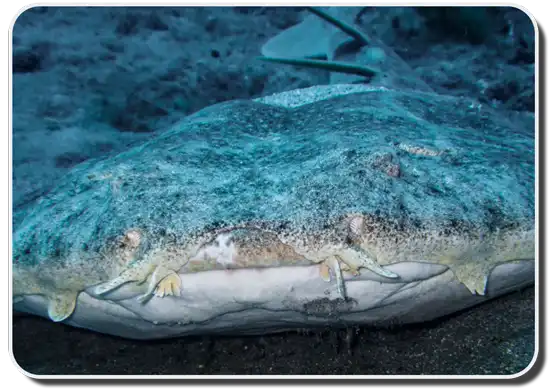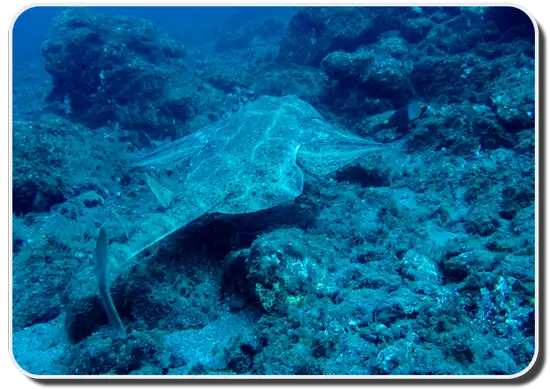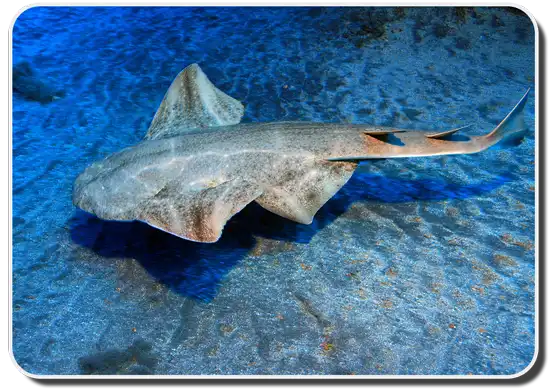
Though they are found in nearly every ocean in the world, Angel Sharks are a lesser known species of shark. Often mistaken for rays, Angel Sharks get their name from their long pectoral and pelvic fins which look like the wings of an angel. These sharks are found along the coast of every continent except Antarctica and highlight the vast diversity among different shark species.
Angel Sharks Have Unique Biology
Angel Sharks grow to an average of 5 feet long and weigh an average of 77 pounds. However some large species of Angel Sharks, like the Japanese Angel Shark, grow to 8.2 feet in length. Angel sharks live between 25 and 35 years and reach maturity at 10-12 years old. There are 23 unique species of angel sharks, but they all share basic physical characteristics that delineate their genus from other sharks.
What makes angel sharks truly unique from other sharks is they have no anal fins. They also have thorns on their back, tails, or head to protect them from attack. Though as they grow larger, they lose their thorns. Finally, they have really unusual caudal fins for sharks. Their upper caudal fin is much longer than their lower caudal fin, which is used to help them propel upward very quickly.
Angel Sharks Are Not Rays
As wide, flat ground dwellers, Angel Sharks are often mistaken for rays. They have long pectoral fins that extend laterally from the sides of their bodies than resemble the fins of a ray. However unlike rays, they have five gill slits on the sides of their heads, while rays have gill slits under their bodies. Though like rays, Angel Sharks have spiracles, a type of gill that delivers oxygen directly to the brain, located on the top of their heads behind two small eyes. Spiracles are typically found on the sides of the heads of rays. Angel Sharks have rounded snouts with large mouths containing nine rows of razor sharp teeth on the upper jaw and teeth rows on the bottom jaw, In the center of their mouths, there is a space with no teeth. Rays have have mouths on their underneath side of their bodies containing a full row of teeth on both sides of their jaws. On the end of their snouts Angel Sharks have barbels, a sensory organ that acts like whiskers to help them detect their prey. Rays do not have barbels. Finally, the bodies of Angel Sharks are longer and more stout than the bodies of rays.
Angel Sharks Are Impressive Hunters
Angel Sharks are bottom dwellers, preferring to hunt in shallow coastal waters. They are ambush predators that typically bury themselves in the mud and sand near prey rich areas like kelp forests, coral reefs, continental shelves, and rocky reefs. They are nocturnal predators that use the bioluminescence of plankton to hunt fish, squids, crustaceans, and mollusks. Angel Sharks use their barbels to sense the movements of their prey in the water. Their eyes are located at the top of their head so when they sense prey, they do not have to move from their position to plan their strike.
Angel Sharks will hunt from the same location for about ten days and then migrate to a new spot. Their hunting grounds tend to be within fifty feet, until they migrate for the season. They never hunt in open water. Instead they lurk camouflaged under the surface and wait patiently for unsuspecting prey to swim by them. They strike out at their prey at a 90 degree angle within an impressive tenth of a second. Angel Sharks use their wide, flat mouths to create a powerful suction and then grab on to their prey with their razor-sharp teeth. Their unique biological characteristics have helped them become impressive hunters.

Angel Sharks Have Unique Reproduction Habits
Though Angel sharks live along the coast line of every continent except Antarctica, they tend to live solitary lives. That is, except when they are mating. Angel sharks typically mate in the springtime in warmer waters. Angel sharks are ovoviviparous, which means their young is born in eggs that gestate in the womb until they hatch. The pups live off a small yolk sac until they are born. Angel sharks tend to have litters of 8 to 25 pups. The pups average 9 to 12 inches when born. Angel shark pups have ocellus, or fake eyes, on their bodies to help them defend against prey until they reach maturity. Unfortunately, the ocellus is only somewhat effective as only 20% of all angel fish pups reach adulthood.
Angel Sharks Are No Threat To Humans
Angel sharks have rarely, if ever attacked humans. They are fairly docile creatures and when insight of humans they will usually just lie still, camouflaged. In the few noted interactions with angel sharks, they have just swum away. There was only one documented case when an angel shark, feeling threatened by a diver in the Mediterranean Sea, took an aggressive stance. The shark swam around the diver with its mouth open and then without attacking, swam away.
Angel Sharks are a very unique species of shark. They have unusual biology, behavior, and habitat. Though they are often mistaken for rays because of their appearance, they have extremely different biological features. They are impressive ambush hunters, but they are not aggressive toward humans. Mostly they spend their lives, quietly hunting prey and blending into the ocean floor.
- Amazing Facts About Angel Sharks
- Facts About The Sawback Angel Shark
- Learn About Another Type Of Shark Here!
